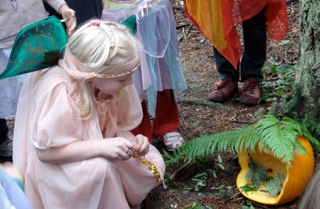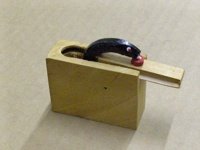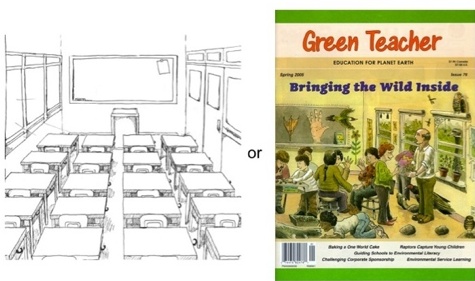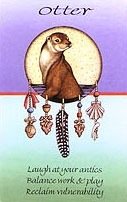Make Friends with Nature
To make friends with Nature is the simple — yet transformative — idea that if we treat the natural world as we would like to be treated, like a friend, then it will treat us kindly in return
(the golden rule).
I strive to learn not just about nature, but from nature as well. I want to make friends with nature, while at the same time respecting it as my teacher. Accordingly, I have to remain in a continual "dialogue" with it, asking what its problems are or what else I should learn.
— Liu Ka-shiang

Helping children to make friends with Nature is something we must do when they are young, in order to give them a lasting sense of comfort in and connection to the natural world, and a deep understanding of their place within it. Given that we now have a generation of young people who did not grow up playing outdoors, who did not make friends with Nature on their own, it is our responsibility as teachers and parents to introduce children to their friends in Nature. In a sense, we have to make "playdates" for them with their plant and animal neighbours — and encourage them to get dirty!
At school, making friends with Nature fits naturally into guided recess/recreation experiences, field trips, outdoor physical education classes, gardening, and lessons or units on friendship and community (a natural!) or safety.
For example, just as we teach children how to obey traffic signs and cross the road safely, we can also teach them how to "read" the natural world and walk safely in it. Here's a fun lesson I have done with primary students:
- I begin by sharing objects that elicit ideas about safety in Nature (these items will change according to where you live):
- slippers (remind us to walk gently)
- a bee puppet (reminds us not to swat at insects, and not to jump into piles of vegetation where they might be nesting)
- a giant seed pod (reminds us not to eat anything in the natural world without adult supervision)
- a stick (reminds us to push branches back attentively and to step carefully around big sticks so they don't thwack us)
- a sun hat (reminds us to dress for sun protection)
- ear muffs (remind us to dress for the weather)

- We then talk about why someone might get a branch in the eye or get stung by a wasp, and how it's not the fault of the branch or the wasp. How can we avoid these unfortunate incidents? (If you can find one of those little boxes that snakes pop out of when you slide open the top, students will be reminded that other animals get startled by us, just as we sometimes get startled by them.)
- Next we go for a walk outside, with everyone pointing out safety issues and Nature friends as we notice them:
- Gently push hanging branches aside, especially for the person behind.
- Don't jump into piles of vegetation until they've been carefully explored for insect nests and other possible hazards.
- Watch for holes in the ground to avoid tripping.
- Don't go out of bounds, even if there's an inviting reason to do so (like a hole in the fence).
- Watch animals and birds quietly; don't frighten them.
- Be careful with prickly plants.
The students came up with most of these "golden rules." See how many more your kids can come up with.
Key concepts taught include perspective, responsibility, causation, and connection. A lesson like this also helps to create students who embody the attributes of principled, caring thinkers.
The point is that if we treat the rest of Nature the same way we would like to be treated — with courtesy, gentleness and respect — then the natural world will treat us like friends.
We must show how School and Mother Nature can become friends again.
— David Sobel, in Childhood and Nature
Another aspect of encouraging students to make friends Nature is ensuring that our classrooms integrate and connect the school community of humans with the natural world.
For example, where would you rather spend your days
working and learning? Which setting would help you make friends with Nature?

In order to help your students make friends with Nature, you can:
- fill your classroom with plants and pictures of animals and other natural things, and have a Nature Corner
- use the term "the rest of Nature" (instead of just "Nature") to continually give the impression that we humans are also part of the natural world
- refer to other species as our friends and neighbours (after all, good neighbours come in all species)
- make outdoor sensory awareness activities (seeing, hearing, smelling, touching, tasting) part of your teaching repertoire
- point out beauty in the natural world
- I once asked a Native Canadian friend how I would recognize my totem animal. "It's an animal who appears to you," he explained, "in real life or in dreams. It's an animal with whom you spend time and share life experiences." I knew right away that my totem animal is the (river) otter — an animal I had "met" several times while canoeing, who seemed to be giving me messages about protecting our beloved river, and who represents, in the Native North American tradition, care and joy and playfulness and balanced feminine energy.
- What is your favourite element — earth, air, fire, water, metal, wood? Why? What does it say about you?
- What are the boundaries of our watershed and our bioregion?
- Each student, in turn, tells the story of something they put into the Friendship Bowl that week/month and something they received from the Friendship Bowl (be sure to model including the rest of Nature when you take your turn).
- The Friendship Bowl can be imaginary/symbolic, but a class-chosen (or class-made) vessel is even better.
- For writing practice, have students write and actually put in the Friendship Bowl what they share with the class.
In the olden times, [hu]man and creature walked as friends who
carried the beauty of the land in their hearts....
If you talk to animals, they will talk with you
and you will know each other.
If you do not talk to them, you will not know them,
and what you do not know, you will fear.
What one fears, one destroys.
— Chief Dan George
Friendship is such an important theme in the lives of children. What better way to help them see their connection to and dependence on the natural world than to have them make friends with Nature?
Return from Make Friends with Nature to Transformative Nature Study
Go from Make Friends with Nature to GreenHeart Education Homepage


